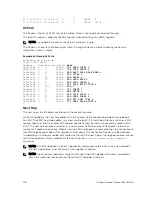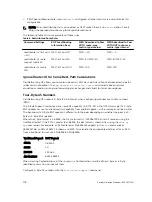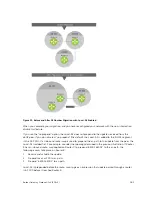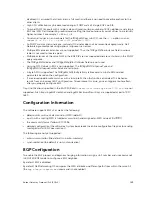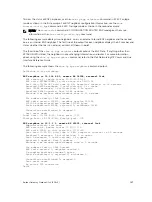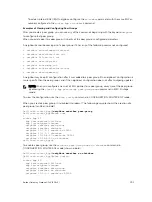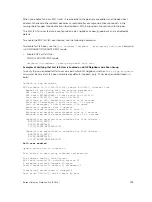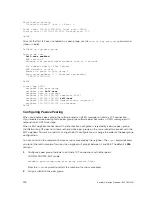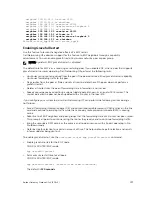
disabled, it is assumed that clients are in a full mesh and there is no need to advertise prefixes to the
other clients.
• High CPU utilization may be observed during an SNMP walk of a large BGP Loc-RIB.
• To avoid SNMP timeouts with a large-scale configuration (large number of BGP neighbors and a large
BGP Loc-RIB), Dell Networking recommends setting the timeout and retry count values to a relatively
higher number. For example, t = 60 or r = 5.
• To return all values on an snmpwalk for the
f10BgpM2Peer sub-OID
, use the
-C c
option, such as
snmpwalk -v 2c -C c -c public<IP_address><OID>
.
• An SNMP walk may terminate pre-maturely if the index does not increment lexicographically. Dell
Networking recommends using options to ignore such errors.
• Multiple BPG process instances are not supported. Thus, the
f10BgpM2PeerInstance
field in various
tables is not used to locate a peer.
• Multiple instances of the same NLRI in the BGP RIB are not supported and are set to zero in the SNMP
query response.
• The
f10BgpM2NlriIndex
and
f10BgpM2AdjRibsOutIndex
fields are not used.
• Carrying MPLS labels in BGP is not supported. The
f10BgpM2NlriOpaqueType
and
f10BgpM2NlriOpaquePointer
fields are set to zero.
• 4-byte ASN is supported. The
f10BgpM2AsPath4byteEntry
table contains 4-byte ASN-related
parameters based on the configuration.
• If a received update route matches with a local prefix, then that route is discarded. This behavior
results from an incorrect BGP configuration. To overcome this issue, you can trigger a route refresh
after you properly configure BGP.
Traps (notifications) specified in the BGP4 MIB draft
<draft-ietf-idr-bgp4–mibv2–05.txt>
are not
supported. Such traps (
bgpM2Established
and
bgpM2BackwardTransition
) are supported as part of RFC
1657.
Configuration Information
The software supports BGPv4 as well as the following:
• deterministic multi-exit discriminator (MED) (default)
• a path with a missing MED is treated as worst path and assigned an MED value of (0xffffffff)
• the community format follows RFC 1998
• delayed configuration (the software at system boot reads the entire configuration file prior to sending
messages to start BGP peer sessions)
The following are not yet supported:
• auto-summarization (the default is no auto-summary)
• synchronization (the default is no synchronization)
BGP Configuration
To enable the BGP process and begin exchanging information, assign an AS number and use commands
in ROUTER BGP mode to configure a BGP neighbor.
By default, BGP is disabled.
By default, Dell Networking OS compares the MED attribute on different paths from within the same AS
(the
bgp always-compare-med
command is not enabled).
Border Gateway Protocol IPv4 (BGPv4)
183
Summary of Contents for Z9000
Page 1: ...Dell Configuration Guide for the Z9000 System 9 7 0 0 ...
Page 80: ...grub reboot 80 Management ...
Page 128: ... 0 Te 1 1 Te 1 2 rx Flow N A N A 128 Access Control Lists ACLs ...
Page 491: ...Figure 70 Configuring OSPF and BGP for MSDP Multicast Source Discovery Protocol MSDP 491 ...
Page 496: ...Figure 73 MSDP Default Peer Scenario 1 496 Multicast Source Discovery Protocol MSDP ...
Page 497: ...Figure 74 MSDP Default Peer Scenario 2 Multicast Source Discovery Protocol MSDP 497 ...
Page 498: ...Figure 75 MSDP Default Peer Scenario 3 498 Multicast Source Discovery Protocol MSDP ...
Page 760: ...Figure 100 Single and Double Tag TPID Match 760 Service Provider Bridging ...
Page 761: ...Figure 101 Single and Double Tag First byte TPID Match Service Provider Bridging 761 ...








